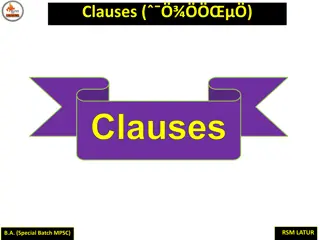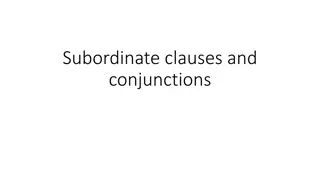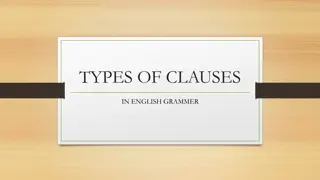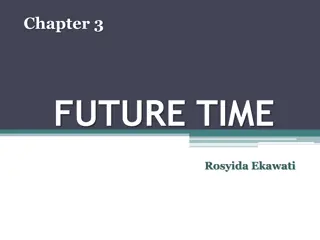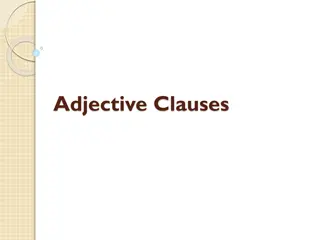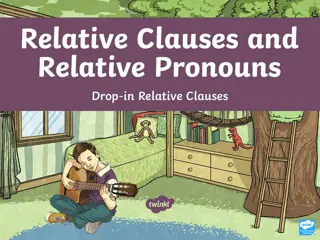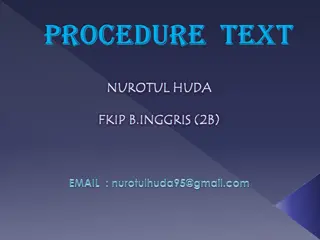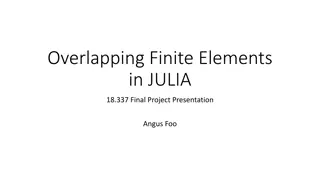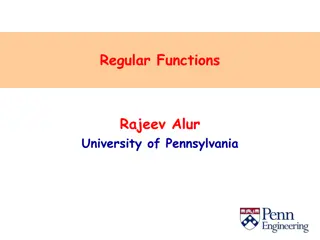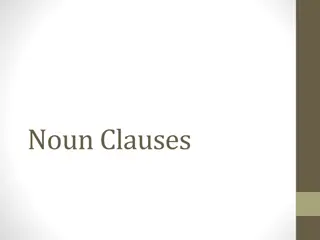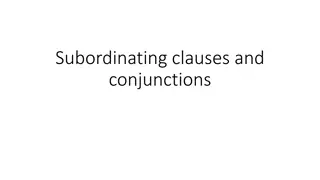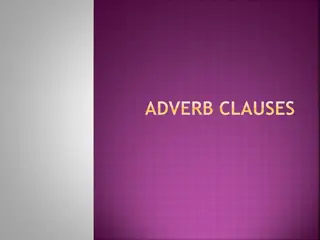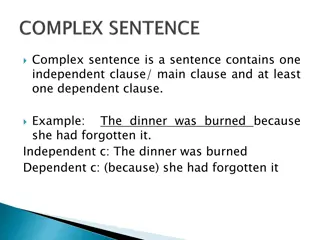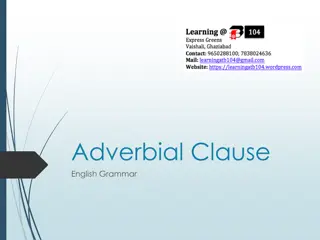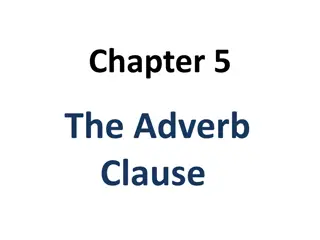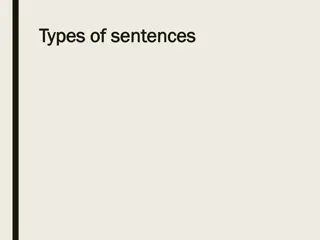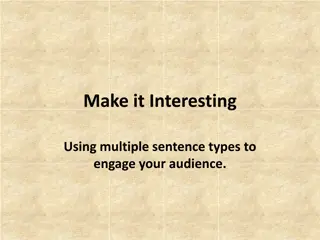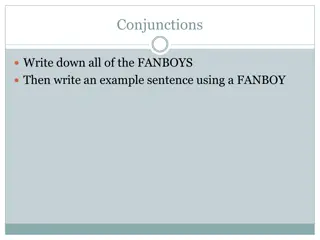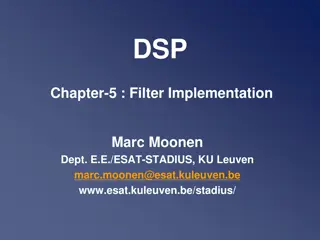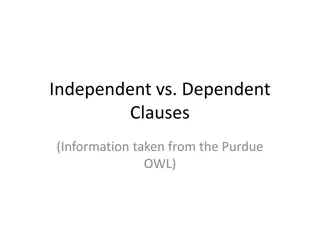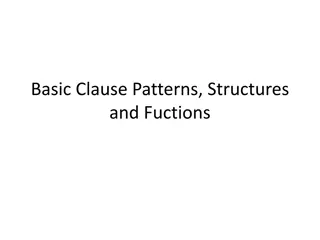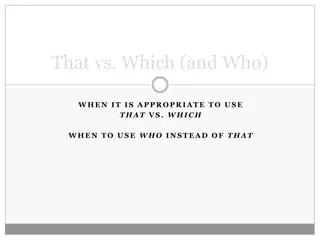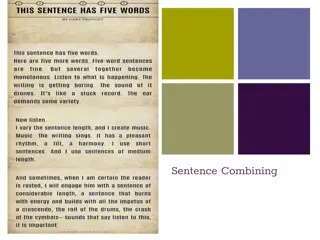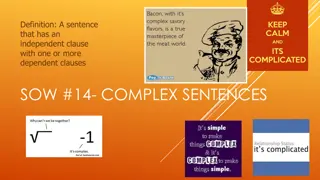Enhancing Information Texts with Non-Finite Subordinate Clauses
Providing layers of detail in information texts involves using non-finite subordinate clauses to establish connections between grammar, meaning, and rhetorical effects. The LEAD principles emphasize linking grammar to writing purposefully, using authentic texts as models, and fostering deep metalinguistic learning. Authentic information/explanation texts contain specific features like clear headings, facts, technical vocabulary, and varied tenses to engage readers. Detailed examples and discussions enhance text comprehension and encourage a deeper understanding of language choices.
Download Presentation

Please find below an Image/Link to download the presentation.
The content on the website is provided AS IS for your information and personal use only. It may not be sold, licensed, or shared on other websites without obtaining consent from the author. Download presentation by click this link. If you encounter any issues during the download, it is possible that the publisher has removed the file from their server.
E N D
Presentation Transcript
Providing layers of detail in information texts by using non-finite subordinate clauses
LEAD Principles PRINCIPLE LINKS EXPLANATION RATIONALE To establish a purposeful learning reason for addressing grammar, and connect grammar with meaning and rhetorical effect Make a link between the grammar being introduced and how it works in the writing being taught To avoid writing lessons becoming mini- grammar lessons, and to allow access to the structure even if the grammar concept is not fully understood To integrate reading and writing and show how real writers make language choices EXAMPLES Explain the grammar through examples, not lengthy explanations AUTHENTIC TEXTS Use authentic texts as models to link writers to the broader community of writers To promote deep metalinguistic learning about why a particular choice works, and to develop independence rather than compliance DISCUSSION Build in high-quality discussion about grammar and its effects
Authentic text Writing to inform and explain Typical features of information/explanation texts include: Headings and sub headings that sum up the topic and sections within it: Famous Buildings/The Taj Mahal Clear statement sentences, especially at the start of paragraphs or sections, that introduce the topic: The use and purpose of a building defines it and gives it meaning, significance and history. Facts and statistics that point out special features: The White House contains 132 rooms, 32 bathrooms, 412 doors, 147 windows, 7 staircases and 3 lifts! Technical or specialist vocabulary to provide an authoritative, expert voice: The central dome is an onion or amrud dome, a style typical of Islamic architecture. Expanded noun phrases that provide detailed description in a succinct and precise way: this perfectly symmetrical marble tomb; tall, decorative spires called guldasta A mix of past and present tense: The cathedral was completed in 1561; It has nine brightly-coloured domes.
Noticing Details in a Text Examples Authentic text Standing in the centre of the Italian capital, the Colosseum was used for gladiator contests, mock battles, animal hunts and religious sacrifices. The White House, situated in Washington D.C., has been the official home and workplace of the President of the United States of America for over 200 years. Built in memory of his favourite wife, Mumtaz Mahal, the Taj Mahal (or Crown Palace) was commissioned by the Mughal Emperor Shah Jahan in 1631. The Colosseum was gifted to the citizens of Rome by Emperor Vespasian to win the public s favour. Discussion One way of adding detail to the information in a text is by using a subordinate clause which has a non-finite verb. Look at the sentences here. Decide what kind of detail is provided by the subordinate clause by asking: What information is lost if you omit the subordinate clause? Links
Noticing Details in a Text Using a subordinate clause which has a non-finite verb can help you add layers of detail in a succinct and precise way. For example, the information in three separate sentences can be incorporated into one sentence: Links Examples The Colosseum was built between 70 and 80 AD. It was gifted to the citizens of Rome by Emperor Vespasian. It was built to win the public s favour. Discussion How many different versions of these sentences can you make? Does the order of the clauses alter the meaning? Built between 70 and 80 AD, the Colosseum was gifted to the citizens of Rome by Emperor Vespasian to win the public s favour. 36 trapdoors were hidden underneath the sandy arena floor. These were opened mid-event. They allowed wild animals or extra gladiators into the arena. 36 trapdoors, hidden underneath the sandy arena floor, were opened mid-event, allowing wild animals or extra gladiators into the arena.
Noticing Details in a Text Using a subordinate clause which has a non-finite verb can help you add layers of detail in a succinct and precise way. Changing the order of subordinate clauses within the sentence can subtly alter emphasis and meaning. Examples The Colosseum was built between 70 and 80 AD. It was gifted to the citizens of Rome by Emperor Vespasian. It was built to win the public s favour. Links Here, the reason for building the Colosseum is foregrounded. Here, the date when the Colosseum was built is foregrounded. To win the public s favour, the Colosseum, built between 70 and 80 AD, was gifted to the citizens of Rome. Built between 70 and 80 AD, the Colosseum was gifted to the citizens of Rome to win the public s favour. 36 trapdoors were hidden underneath the sandy arena floor. These were opened mid-event. They allowed wild animals or extra gladiators into the arena. Discussion Decide on one sentence where the order of clauses emphasises the position of the trapdoors within the Colosseum and the surprise of them opening during the show.
Noticing Details in a Text Using a subordinate clause which has a non-finite verb can help you add layers of detail in a succinct and precise way. Changing the order of subordinate clauses within the sentence can subtly alter emphasis and meaning. Examples Is this the version you chose to emphasise the position of the trapdoors within the Colosseum and the surprise of them opening during the show? Links Hidden underneath the sandy arena floor, 36 trapdoors were opened mid-event, allowing wild animals or extra gladiators into the arena. You might emphasise the drama of the event even more by starting a sentence with a new non-finite subordinate clause: Opening mid-event, . How could you complete this sentence? Is this how you completed the sentence ? Opening mid-event, 36 trapdoors hidden underneath the sandy arena floor allowed wild animals or extra gladiators into the arena.
Verbalising the Grammar-Writing Link A crucial element of the LEAD principles is helping writers to think explicitly (metalinguistically) about the choices they make. As a teacher, you need to support this by being crystal clear yourself about how you verbalise the link between a grammar choice and its effect in a particular text/context. Then express this in student-friendly language, as below. Verbalisation to share with students: In an information or explanation text, you need to provide layers of detail in a precise and succinct way. One way of providing this detail is to use subordinate clauses formed with non-finite verbs. Think about where in the sentence you can place these subordinate clauses to subtly alter the emphasis on meaning.


